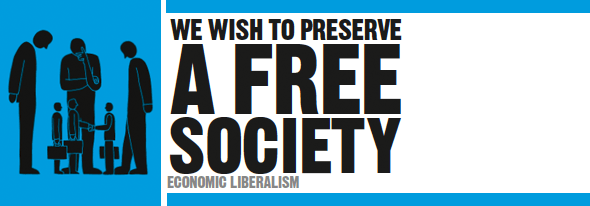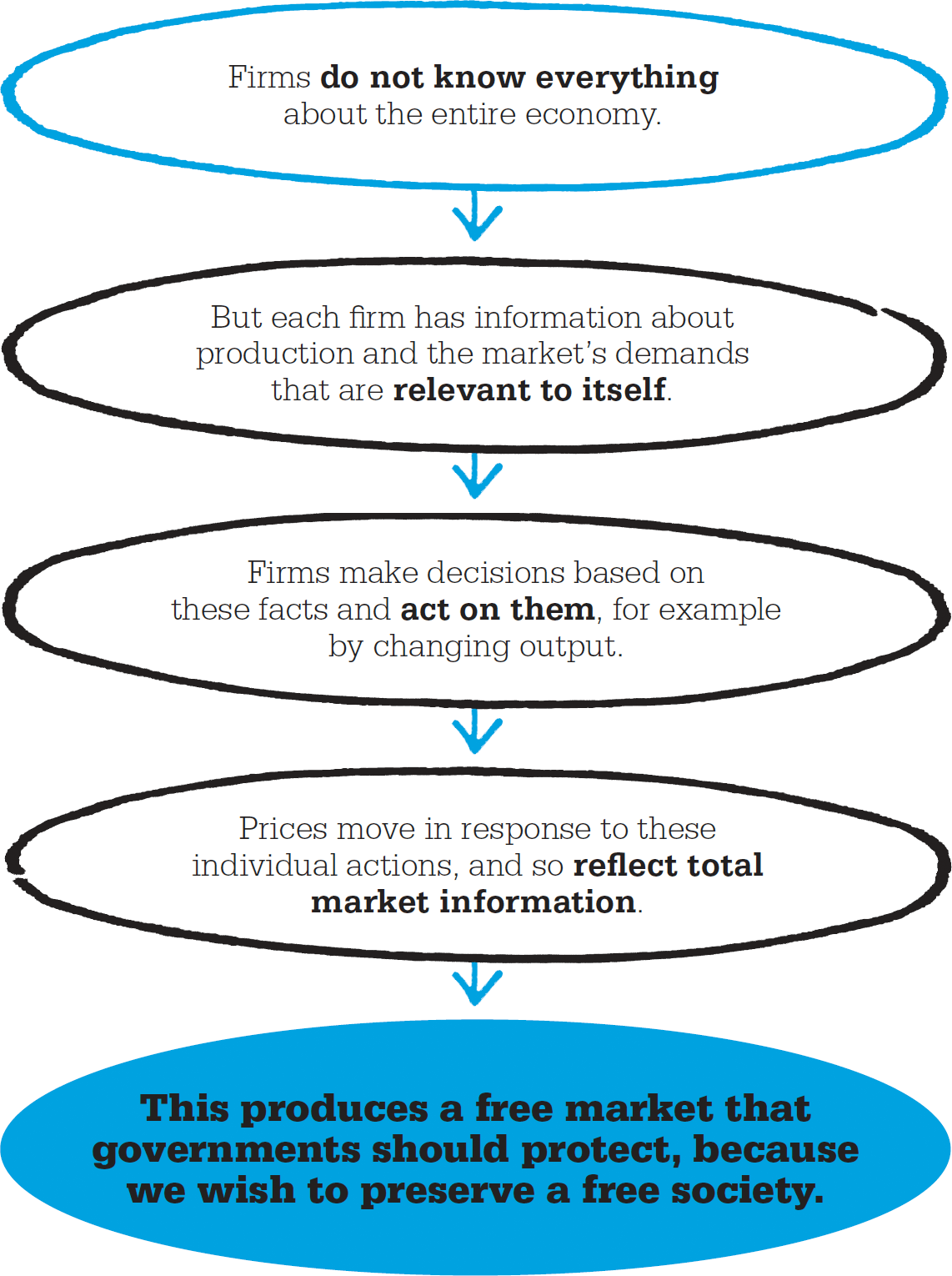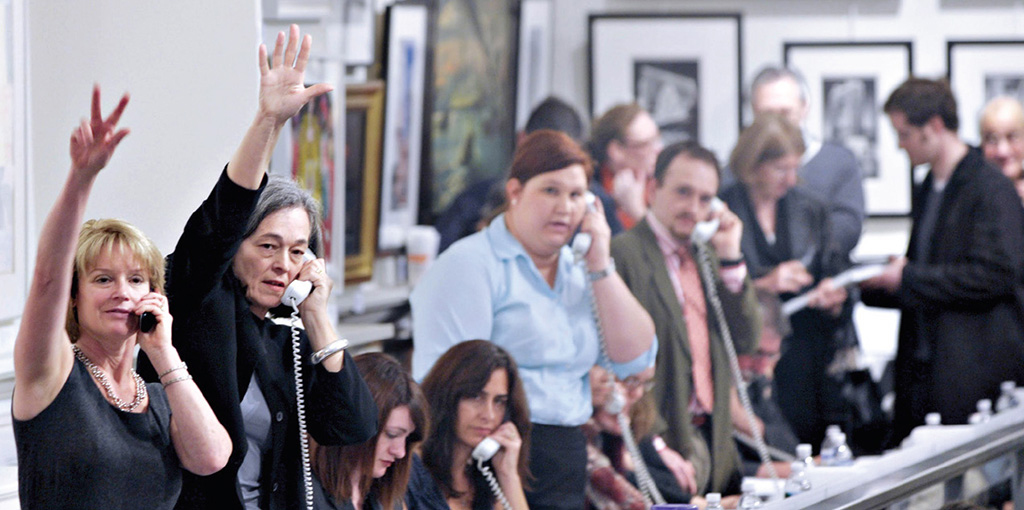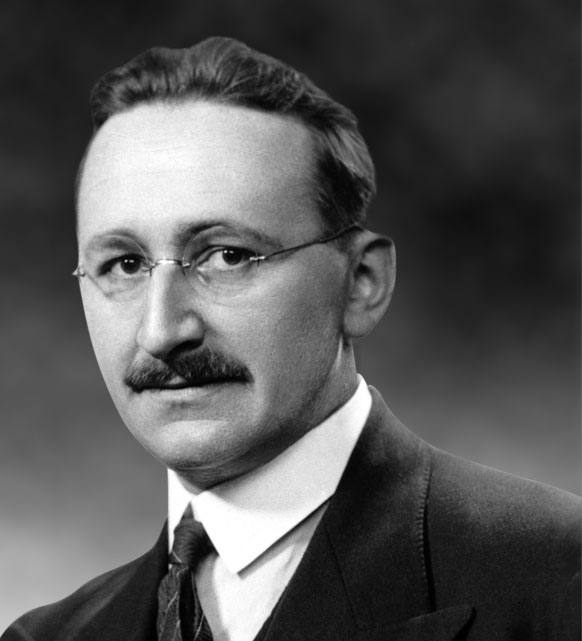

Society and the economy
Friedrich Hayek (1899–1992)
1908 Italian economist Enrico Barone shows how a central government planner can replace the free market if it can calculate prices.
1920 Ludwig von Mises refutes Barone’s argument.
1936–37 Oskar Lange argues against von Mises’s position.
1970s Hayek’s arguments for free markets gain ground.
1991 US historian Francis Fukuyama says free market capitalism has defeated all possible alternatives.
Late 2000s Criticisms of government bank bailouts prompt a revival of interest in Hayek’s ideas.
Mainstream economics has always had its critics. Its focus on mathematical formulas and its sometimes sweeping assumptions have led economists to challenge both its methods and its lack of empirical evidence. Many of these critics have been from the political Left, who see the mainstream as providing a glossy support for an unjust free market.

One minority tradition, the Austrian School, has argued quite differently. Vociferous defenders of the free market, but critical of the mainstream, they have carved out a unique place within the discipline. Most prominent of these radicals was an Austrian-British economist, Friedrich Hayek. Hayek vies with John Maynard Keynes for the title of the 20th century’s most influential economist, and he made a range of contributions to political and economic thought. These covered economics, law, political theory, and neuroscience. His writings maintained a closely argued, consistent set of principles, which he saw as being in the tradition of classical liberalism: support for free markets, support for private property, and deep pessimism about the ability of governments to shape society.
"The more the state ‘plans’, the more difficult planning becomes for the individual."
Friedrich Hayek
The argument for which Hayek is best remembered appeared in 1944 in The Road to Serfdom. At the time there was a growing enthusiasm for government intervention and central planning. Hayek argued that all attempts to impose a collective order on society are doomed to failure. He said they would lead, inexorably, to the totalitarianism of fascism or Stalinist communism. Since all planning necessarily acts against the “spontaneous order” of the market, it can only occur with a degree of force, or coercion. The more that a government draws up plans and imposes them, the more coercion is needed. As governments are poorly informed about the detailed workings of the market, planning is bound to steadily fail in its aims, while becoming increasingly coercive to compensate for those failings. At that point a society would lurch toward a totalitarian state, in which all freedom was extinguished, however moderate the planners’ initial goals.
Economists of the Left had argued that a centrally planned economy was not only possible, but more efficient than a free market. Their first significant opponent, in 1920, was another member of the Austrian School, Ludwig von Mises. He argued that socialism—here defined as central planning—is not economically viable. It offers no rational means of pricing commodities since it relies on the diktat (unquestionable command) of one central planner or committee to perform the allocation decisions that in a free market are undertaken by many hundreds of thousands of individuals. The amount of information needed to assess the scarcities and surpluses of a market and set prices correctly is so huge that the attempt is doomed to failure. Socialism, wrote von Mises, is the “abolition of the rational economy.” Only a free market with private property can provide the basis for the decentralized pricing decisions a complex economy requires.

The totalitarian state of North Korea suffers regular shortages and famine. Economists of the Austrian School claim that this is the inevitable result of central planning that ignores markets.
Polish economist Oskar Lange, however, disagreed with von Mises. He famously responded to von Mises’ claims in a 1936 article, On the Economic Theory of Socialism, using a development of general equilibrium theory. This theory, which was not perfected until after World War II, is a mathematical representation of a market economy stripped to its bare essentials. All imperfections in markets have been removed, and all participants in the market are fully informed and concerned only with their self-interest. On this basis, Lange said, a central planning board could fix the initial set of prices for the economy, and then allow all those in society to trade freely, adjusting their demand and supply around the prices given. The planning board could then adjust prices according to demand and supply. The outcome, he argued, would be efficient. A planner could also reduce income inequalities and constrain the market’s tendency to short-term thinking.
Lange had taken the usual assumptions of microeconomics (that supply and demand determine price), and turned them on their head. His work later formed the basis for welfare economics, which looks at how free markets can achieve socially desirable aims.
However, Hayek and his colleagues offered quite a different version of the free market’s virtues. They did not assume that markets lack imperfections or that individuals are completely informed. To the contrary, they argued, it is because individuals and firms are poorly informed and society imperfect that the market mechanism is the best way to distribute goods. This view became an important tenet of the Austrian School of thought.
In a situation of continual ignorance, Hayek argued, the market is the best available means not to provide information, but to acquire it. Each individual and every firm knows their own situation best: they have goods and services people demand, they can plan for the future, and they see the prices that are relevant to them. Information is specific and dispersed among all those in society. Prices move in response to actions by individuals and firms, and so come to reflect the entire amount of information available to society as a whole.
Hayek maintains that this “spontaneous order” is the best available means to organize a complex modern economy, given that knowledge about society can never be perfect. Attempts to impose collective restraints on this order represent a reversion to primitive, instinctual orders of society—and the free market must be defended against this.

The free flow of information between individual sellers and vendors results in the correct pricing of goods, according to Hayek. Centrally planned economies, on the other hand, impose the view of one person or committee, curtailing individual freedom to communicate and firms’ ability to trade.
The idea of spontaneous order came to dominate Hayek’s thinking, and his writing turned increasingly to political questions. These were discussed most fully in The Constitution of Liberty (1960), which argues that government should act only to preserve the spontaneous workings of the market, in as far as this is possible. Private property and contracts are legally sacrosanct, and a free society must observe rules that bind all parties—including the state itself. Beyond this, the state can, if the need arises, act against those collectivist forces threatening to undermine the rule of law. Hayek was broadly in favor of democracy, but critical of its inclination in some cases toward a “democratic tyranny of the collective.”
Following World War II the necessary rebuilding of countries led to a Keynesian consensus, which proposed increased government intervention in the economy. At the same time Hayek and others in the Austrian School formed the Mont Perelin Society, which acted as a guiding influence on the free market think tanks that arose during the breakdown of the Keynesian consensus in the 1970s. A similar new approach to economic policy sprang up in South America, but it was its adoption by the governments of Ronald Reagan in the US and Margaret Thatcher in the UK that made it globally significant. This was neoliberalism, and it followed closely the ideas of the once-maligned Austrian School.
Nationalized industries were privatized, and governments rolled back their intervention in the workings of the market. The Soviet Union collapsed, giving further impetus to the apparent triumph of Hayekian themes in politics. Across the world even those parties once most adamantly opposed to free markets came to believe that there was no viable alternative, including Britain’s Labour Party—who had been the direct target of Hayek’s Road to Serfdom.
Mainstream economists strongly influenced by free market thinking, such as Milton Friedman, have risen to influence. By 2000, a “new consensus” prevailed in macroeconomics that emphasized the limited role of the state.

Auctions are free markets where prices arise from the direct and rapid exchange of localized information between buyers and sellers.
Despite the apparent triumph of Austrian themes in economics and Hayek’s 1974 Nobel Prize, the distinctive methods and theory of the Austrian School remained largely confined to the fringes. However, the collapse of the global financial system in 2007–08 and the subsequent bank bailouts have provoked a renewed interest in its doctrines. Austrian School economists have been prominent in attacking bank bailouts, claiming that they represent an unwarranted interference in the market. The Free Banking School, which calls for an end to the government monopoly of the money supply, takes its cue from a 1976 Hayek paper, Denationalization of Money, and its ideas have gained ground. Keynesian programs of increased government spending have been similarly criticized. With mainstream economics in a continuing state of turmoil, the Austrian School is set to achieve fresh influence.

Friedrich August von Hayek was born in Vienna, Austria, to a family of intellectuals. By the age of 23, he had received doctorates in law and politics in addition to spending a year in the Italian army during World War I. Initially drawn to socialism, he attended Ludwig von Mises’ seminars while in Vienna, and with von Mises’ support founded the Austrian Institute of Business Cycle Research. In 1923, he traveled to New York for a year, and the accuracy of US newspaper accounts of the war compared to those in Austria led to his deep distrust of governments.
In 1931, he moved to London to teach at the London School of Economics and became embroiled in a very public, two-year argument with John Maynard Keynes. Hayek became a British citizen in 1938, but in 1950 left London for the University of Chicago. He died aged 93 in Freiburg, Germany, in 1992.
1944 The Road to Serfdom
1948 Individualism and Economic Order
1988 The Fatal Conceit